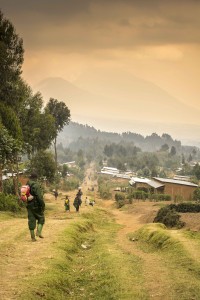
Seeing mountain gorillas in Rwanda in the wild is one of the most memorable experiences you can have. Here’s how you can do it:
Where do you need to go?
You can see gorillas in their natural environment in Rwanda and Uganda. Parts of the Democratic Republic of Congo are a possibility, but the political situation is volatile at the moment.
Best time to go?
Avoid the rainy seasons i.e. don’t go between March to May and September/October to November if you can help it.
Permits may be easier to get during those times, but will be almost as expensive.
If you’re spending that much money, you don’t want to be trekking and spending your precious hour with the gorillas in pouring rain. The hike to see them can be tough enough without having to trudge through mud and worry about your camera getting wet.
It can still rain during the dry season of course, but if you can, maximise your chances of avoiding rain by avoiding the wet season.
How do you arrange it and how much does it cost?
You need a permit, which is expensive. The area surrounding the gorillas is protected and heavily guarded. You can’t go wandering through the forest looking for them yourself. Instead a guide will take you in a group of up to 8 people.
Permits cost US$750 each (less for residents) in Rwanda, and US$600 each in Uganda. There will often be transaction fees on top, plus a commission if you’re using an agent. You also need to budget for the cost of getting to and around Rwanda/Uganda, as well as accommodation, which can be expensive.
Using a reliable agent or tour company to book the permit and make arrangements for you is the easiest way to go. Tour prices are generally cheaper during the rainy season as there’s less competition for accommodation. We traveled with Intrepid Travel who were good.
Many permits are booked out in advance by travel agents so they can be difficult to get independently. Contact the Rwanda Development Board or the Bwindi National Park for further information.
What happens on the day?
Tourists are organised into groups of 8.
Each group is assigned a family of gorillas.
Each gorilla family is categorised as requiring a short (1-2 hour); medium (2-3 hour); or long (3-4), walk to see the gorillas.
If you are desperately unfit, or old and want a shorter walk, the guides will arrange for you to see a family which is only a short walk away.
There are several families of gorillas living on the mountain. The families are constantly moving. Park rangers track the families on foot, and communicate with the park office with radios. At the end of the day, the park trackers will note where they are so that they can be easily found for the next day’s tourists.
Some families of gorillas are more famous than others. For example, the Susa group in Rwanda which was studied by Dian Fossey is one of the biggest and the one that most people want to see.
You are not supposed to be able to pick which group of gorillas to see, although I wouldn’t be surprised if it does happen in some cases. Seeing a large group of gorillas would be awesome, but you’ll be amazed with whatever experience you get, so don’t worry about it.
The trails that lead to the gorillas start on farmland and progress slowly up hill before getting to the mountain forest. Once in the forest, your guide will usually have to machete his way to the gorillas.
When you get near the gorillas, armed guards might join you. You can leave your bags with one of the guards, and spend at least an hour with the gorillas before walking back.
The gorillas move around and live on the mountain, so expect to be walking up hill at altitude. At the top, the altitude was about 3,000m – it was hard work, humid and hot. We were supposed to have a “medium” long walk, but since the gorillas kept moving, we ended up walking uphill for about 3 hours. We had to walk back too, so it was a long day.
What do you need to wear?
Most people will have to walk up a fairly steep hill in open countryside before their guide starts macheting their way into the forest.
For the hiking, you will need sturdy shoes, some light trousers and maybe a tshirt if its warm, and waterproofs in case it rains. We were advised to wear dark colours, preferably dark green, which is what the park rangers also wear. We didn’t see any Tstese flies when we visited.
Good hiking boots, and wicking fabrics are best. It’s humid and you’ll be walking at altitude which will make you hotter.
Don’t forget to take a dry bag for your camera in case it rains.
In the forest, there are prickles everywhere, so you will need a long sleeved top and some sort of over-trousers or gaiters are also recommended. The prickles/stinging nettles on steroids are painful and easily get through your trousers. There are also snakes! Although snakes do tend to stay out of your way if they hear you coming, it doesn’t hurt for you to have a bit more protection.
Our guide put on heavy duty waterproof pants over his trousers as soon as we got to the edge of the forest.
Good gardening or skiing gloves are another necessity. Deep in the forest, I was crawling up river beds, and hawling myself over huge fallen tree trunks. I wouldn’t have been able to do that easily if I didn’t have proper gloves – there are uber strong nettle leaves and prickles everywhere.
Beware of fire ants. Thick socks help. Most people tuck their trousers into their socks in case they step on the ants which can climb up and give you a nasty bite.
A stick for walking with can be arranged before you start your walk. I didn’t have one but it could have been useful. Don’t bother bringing your own, just pay US$10 for one made by a local at the beginning.
Local porters are also around, and will carry your bag, and help you up the mountain for $10+ per day. Even if you don’t take up the offer of a porter, most groups will have at least one guy following them until one of you breaks.
What is it like – seeing gorillas in the wild?
Surreal!
It’s a strange and fascinating experience. We saw babies, young gorillas, old gorillas. We got to watch them eat, sleep, play, fight. Seeing these huge furry almost human-like animals going about their daily business was amazing.
Our group of gorillas were in a particularly leafy and forested area. Other groups got to see their gorillas in an open area where it was much easier to take photos that were not blocked by leaves and shrubbery.
You can take photos but should try to keep a reasonable distance if possible. Your guide will let you know if you’re getting too close.
Almost all the groups we saw had a few baby gorillas.
The gorillas are used to tourists coming in and watching them for an hour each day. I’d love to know what they think of us.
They can apparently recognise some of the guides, who try and imitate their cooing/grunting noises so that the gorillas feel safe.
My boyfriend, Andrew, had an interesting experience. Half way through our time with the gorillas, Andrew stepped on to a path to take a photo of the huge silver back we had all been photographing. The gorilla was a few metres in front of him. All of a sudden, Andrew saw an angry face and a furry 180kgs charging towards him. The rest of us huddled together in shock and fear, while the guide who was standing next to Andrew spun himself and Andrew around. They stood motionless with their backs to the silverback. The silverback stopped just behind them. Andrew could feel the silverback breathing down his back! He wasn’t sure what was going to happen. Then a powerful hairy hand gave him a smack across the bottom of his back. The silver back was teaching him a lesson. Don’t block my path bro, I’m in charge.
Others in our tour group had nicer experiences, like a new born baby gorilla playing with his foot and leg, as he just stood there looking down at him.
How long does it take?
Some people were lucky and managed to locate the gorillas in less than an hour, so finished in the morning.
Other people, like us, ended up walking for 6-7 hours. Even with a shorter journey on the way back, it was a pretty long and exhausting day but that just made it all the more memorable.
Was it worth the money?
It’s a lot of money, yet I haven’t met anyone who regretted going, or anyone who didn’t enjoy themselves.
If you’re interested in animals, then seeing the gorillas in their natural habitat is a once in a life time experience. If you have the chance and the money to go, do it.


